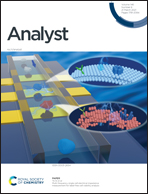Measuring temperature heterogeneities during solar-photothermal heating using quantum dot nanothermometry†
Abstract
Small metallic nanoparticles with appropriate surface plasmon resonance frequencies can be extremely efficient absorbers of solar radiation. This efficient absorption can lead to localized heating and highly heterogeneous temperatures. These unique optical properties have inspired research into the development of environmentally relevant solar-to-heat conversion technologies that are based on the light absorption of nanomaterials. The development of robust, reliable, and straight-forward techniques for measuring spatially resolved temperatures in photothermally heated systems can be an indispensable tool to aid future work in this area. Herein, we consider the application of a fluorescent technique that can measure spatially resolved temperatures in solar photothermal systems using CdSe quantum dots (<10 nm diameter). The local temperature of the quantum dot can be determined by monitoring the shift in its fluorescence wavelength resulting from the dilatation of the lattice with increasing temperature. To exploit this property, we fabricated Au nanorod-quantum dot architectures using linkers of varying lengths, and measured the light induced temperature change increasing more rapidly closer to the surface of an Au nanorod. We also compared the effect of Au nanorod coatings and found that silica coating leads to higher overall temperatures compared to organic stabilized Au nanorods.



 Please wait while we load your content...
Please wait while we load your content...
